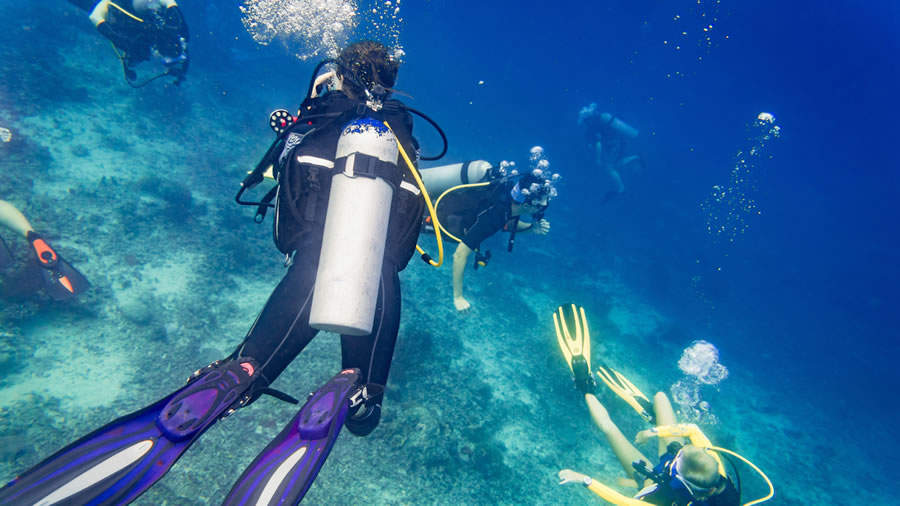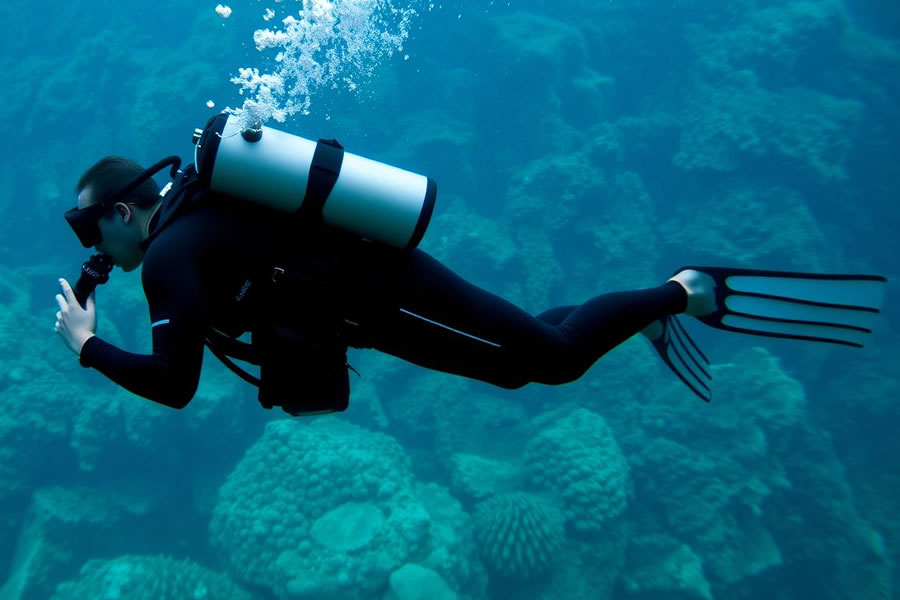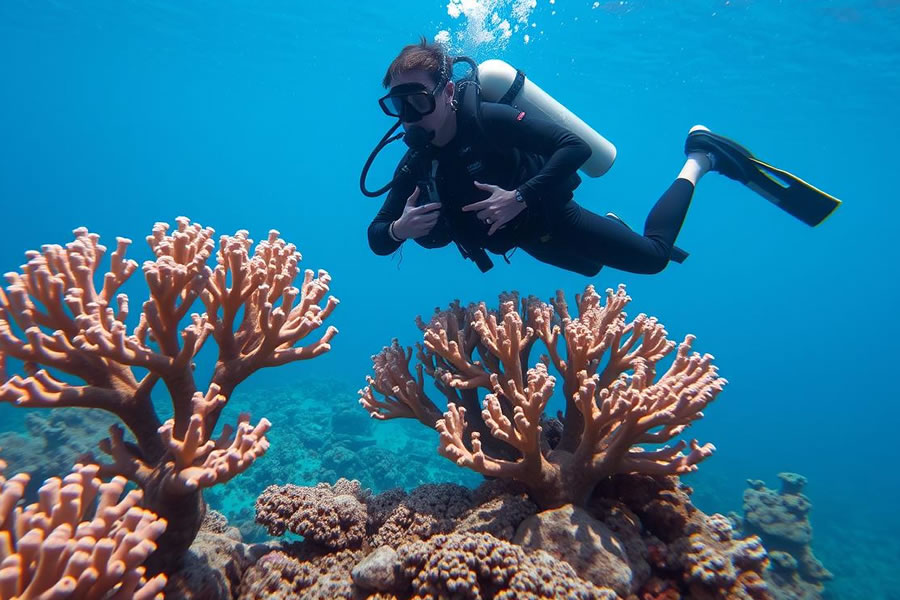How Much Dive Weight Do I Need? A Diver’s Guide to Perfect Buoyancy Control
Finding the right dive weight is crucial for every scuba diver. Too little, and you’ll struggle to descend; too much, and you’ll sink fast, wasting air and energy. Proper weighting affects your comfort, safety, air use, and even helps protect marine life.
This guide breaks down everything you need to know—from the key factors that influence buoyancy to simple ways to calculate your ideal weight. Whether you’re new to diving or refining your skills, you’ll learn how to reach that perfect, effortless neutral buoyancy.
Factors Affecting How Much Dive Weight You Need

Multiple variables determine the amount of weight you’ll need to achieve neutral buoyancy underwater. Understanding these elements is crucial before calculating your specific requirements.
Perfect buoyancy control allows for effortless hovering and minimal impact on marine environments
Body Composition and Personal Factors
Your body’s natural buoyancy varies considerably based on your individual physical characteristics:
- Dense muscle tissue naturally sinks in water, while fat tissue provides positive buoyancy
- Divers with higher muscle-to-fat ratios typically require less weight to descend
- Individuals with higher body fat percentages generally need more weight to overcome natural buoyancy
- Female divers often require proportionally more weight than males of similar size due to naturally higher body fat percentages
- Lung capacity significantly affects buoyancy—larger lung volume creates more positive buoyancy when fully inflated
Exposure Protection Influence
Your thermal protection is among the most significant factors affecting your weight requirements:
| Thermal Protection | Approximate Weight Needed | Key Considerations |
| Swimsuit/Rashguard | 2-4 lbs (1-2 kg) | Minimal buoyancy effect, suitable for tropical diving |
| 3mm Wetsuit | 4-8 lbs (2-3.5 kg) | Common for warm water (75-85°F/24-29°C) |
| 5mm Wetsuit | 6-12 lbs (3-5.5 kg) | For moderate temperatures (65-75°F/18-24°C) |
| 7mm Wetsuit | 10-14 lbs (4.5-6.5 kg) | For cooler waters (55-65°F/13-18°C) |
| Drysuit (light undergarment) | 12-18 lbs (5.5-8 kg) | Significant air volume requires additional weight |
| Drysuit (heavy undergarment) | 16-26 lbs (7.5-12 kg) | Maximum insulation for cold water environments |
Understanding Wetsuit Buoyancy Physics
Neoprene contains thousands of tiny nitrogen bubbles that create substantial positive buoyancy. A standard 5mm wetsuit provides approximately 6-8 pounds (2.5-3.5 kg) of positive buoyancy that must be counteracted with weights.
As you descend, water pressure compresses these bubbles, reducing buoyancy and effectively making your weights “heavier” at depth—a critical consideration for maintaining consistent neutral buoyancy throughout your dive profile.
Water Type and Salinity
The type of water you’re diving in dramatically impacts your buoyancy needs:
- Salt water is approximately 3% denser than freshwater, providing significantly more buoyancy
- You’ll typically need 4-7 lbs (2-3.5 kg) more weight when diving in salt water compared to freshwater
- Extremely saline environments like the Dead Sea would require substantially more weight
- Brackish water (mixed fresh and salt) requires an intermediate amount of weight
- Always recalculate your weight requirements when transitioning between salt and freshwater environments
The same diver requires significantly more weight in salt water (left) than in freshwater (right)
Equipment Buoyancy Characteristics
Your diving gear contributes substantially to your overall buoyancy profile:
- Aluminum tanks become increasingly buoyant as air is consumed (up to +5 lbs/2.3 kg when empty)
- Steel tanks remain negatively buoyant even when empty (-3 to -8 lbs/-1.4 to -3.6 kg)
- BCD type and material affect baseline buoyancy characteristics
- Underwater cameras, dive computers, and accessories add weight that may reduce your weight belt requirements
- Fins vary in buoyancy—some models float while others have slight negative buoyancy
Common dive weight options: traditional blocks, coated weights, soft pouches, and specialized trim weights
Need Professional Help Finding Your Perfect Weight Balance?
Before entering the island’s crystal-clear waters, divers can benefit from personalized weight checks and equipment consultations offered by the Dive Center in Nusa Lembongan. Their experienced instructors help ensure each diver achieves the ideal buoyancy setup for a safe and enjoyable dive.
How to Calculate How Much Dive Weight You Need
Determining your ideal weight requirement isn’t an exact science, but several proven methods can help you find the right starting point for your specific combination of body type, equipment, and diving environment.
The Essential Surface Float Test
This practical in-water test is considered the gold standard for determining your proper weighting:
Surface Float Test Step-by-Step Procedure
- Wear all your diving equipment exactly as you’ll use it during the actual dive
- Enter water that’s deep enough that you cannot touch the bottom
- Completely deflate your BCD and maintain a vertical position
- Take a normal breath (not fully inflated lungs)
- Add or remove weight until you achieve the correct position
- Verify by exhaling completely—you should sink slowly when your lungs are empty
- Add 2-4 pounds (1-2 kg) as a safety margin for open water conditions
The ideal position: With a normal breath, the water level should be at eye level or at the top of your mask. When you exhale completely, you should sink slowly and steadily.
Starting Point Weight Formulas
While not precise for everyone, these formulas provide a useful starting point before fine-tuning with a float test:
Basic Weight Calculation Formula
- Saltwater starting point: 10% of your body weight
- Freshwater starting point: 7% of your body weight
- Add 6-8 lbs (2.7-3.6 kg) for a 7mm wetsuit
- Add 12-16 lbs (5.4-7.3 kg) for a drysuit with medium undergarment
- Subtract 3-6 lbs (1.4-2.7 kg) if using a steel tank instead of aluminum
Sample Calculation Example
For a 170 lb (77 kg) diver in saltwater with a 5mm wetsuit and aluminum tank:
- Base weight: 170 × 10% = 17 lbs (7.7 kg)
- 5mm wetsuit: +6 lbs (2.7 kg)
- Aluminum tank: No adjustment
- Total starting weight: 23 lbs (10.4 kg)
- Fine-tune with surface float test
Digital Buoyancy Calculators
Online tools can provide more personalized estimates based on your specific parameters:
- Enter your height, weight, body type, and gender
- Specify your exposure protection details (type, thickness)
- Add information about your tank material and size
- Include details about additional equipment (cameras, etc.)
- Select salt or freshwater environment
These calculators provide a solid starting point, but always verify with a practical surface float test before your dive, as individual factors can significantly affect the theoretical results.
The Weight Check Dive
For the most accurate weight determination, perform a dedicated weight check dive:
- Begin with slightly more weight than you estimate you’ll need
- Descend to 15 feet (5 meters) and establish neutral buoyancy
- Note how much air is in your BCD to maintain neutral buoyancy
- At the end of your dive with 500 PSI (35 bar) remaining:
- Stop at 15 feet (5 meters), completely empty your BCD
- You should be able to hover or sink very slowly
- If you float upward, you need more weight; if you sink rapidly, you have too much
Weight Distribution and Placement Techniques
How you distribute weight on your body is equally important as the total amount. Proper weight placement affects your trim, comfort, and ability to maintain an optimal horizontal position underwater.

Traditional Weight Belt Configuration
The classic weight belt remains popular for its simplicity and reliability:
- Position the belt above your hip bones to prevent slipping during the dive
- Distribute weights evenly around your waist for optimal balance
- Place slightly more weight toward your back for better trim
- Keep the buckle area free of weights for quick release in emergencies
- Ensure at least 6 inches (15 cm) of excess strap after the buckle
- Thread the belt through weight keepers if your wetsuit has them
Proper weight belt positioning: above hip bones with easily accessible quick-release.
Integrated Weight Systems
Modern BCDs often feature integrated weight systems that offer improved comfort and weight distribution:
Front Loading Weight Pockets
- Typically hold 60-70% of your total weight
- Balance weight equally between left and right sides
- Ensure pockets click securely into place
- Practice removing and replacing weight pockets
- Verify that quick-release mechanisms function smoothly
Rear Trim Weight Pockets
- Hold 30-40% of your total weight
- Help maintain horizontal position underwater
- Reduce strain on lower back during surface swimming
- Not designed for emergency weight release
- Should be balanced between left and right sides
Specialized Weight Placement Options
Beyond standard systems, these specialized weight options help fine-tune your buoyancy profile:
| Weight Type | Placement Location | Benefits | Important Considerations |
| Ankle Weights | Around ankles | Corrects leg buoyancy, improves trim | Start with 1 lb (0.5 kg) per ankle; not for emergency release |
| Tank Weights | Around tank bottom | Counteracts tank buoyancy, improves trim | Shifts center of gravity; may require BCD adjustment |
| V-Weights | On tank valve/first stage | Counterbalances lightweight regulators | Small amounts only (1-2 lbs/0.5-1 kg) |
| Trim Pockets | Various points on BCD/harness | Customizable distribution for perfect trim | More complex setup; requires experience |
| Weight Harness | Across shoulders/chest | Distributes weight across upper body | Used primarily in technical diving |
Master Advanced Buoyancy Control with Professional Training
Join with Divemaster Course Indonesia where you’ll master advanced buoyancy techniques, weight distribution secrets, and professional-level trim adjustments in the pristine waters of Indonesia. This course is designed not only to refine your control underwater but also to prepare you for leadership roles in diving.
Through hands-on practice, theory sessions, and guided dives, you’ll develop the skills needed to move effortlessly, reduce air consumption, and assist other divers with confidence.
Buoyancy Fine-Tuning Beyond Dive Weights
While proper weighting forms the foundation of good buoyancy control, mastering these additional techniques will elevate your diving experience to the next level.

Breath Control: Your Natural Buoyancy Tool
Your lungs are your most powerful and responsive buoyancy control device:
- A full inhalation can add 8-12 lbs (3.6-5.4 kg) of buoyancy
- Practice controlled breathing for micro-adjustments in depth
- Use slight inhalation to rise, slight exhalation to descend
- Maintain consistent breathing rhythm for stable buoyancy
- Never hold your breath (dangerous and destabilizes buoyancy)
Breath Control Exercise for Buoyancy Mastery
Try this pool exercise to develop precise breath control: Hover at a fixed depth with minimal BCD inflation. Place a small object (dive token) on the bottom. Using only your breathing, lower yourself to pick up the token, then rise back to your original position—all without using your hands or fins for movement.
This develops the fine breath control that distinguishes expert divers from beginners and dramatically improves your buoyancy precision.
BCD Usage Techniques
Proper BCD operation complements your weighting system:
- Add air in short bursts rather than long inflations
- Allow 3-5 seconds for air to distribute throughout the BCD
- Maintain minimal air in your BCD once at depth
- Anticipate buoyancy changes before they occur
- Add small amounts of air as your tank becomes lighter during the dive
- Practice hovering with different BCD inflation levels
Body Positioning and Trim
Your body position significantly affects your buoyancy profile:
- Maintain a horizontal position with legs slightly elevated
- Keep arms folded or at your sides to reduce drag
- Point fins slightly downward to maintain trim
- Use small fin movements rather than hand sculling
- Keep your head in line with your spine (avoid looking down)
- Practice frog kicks and modified flutter kicks for minimal disturbance
Environmental Adaptations
Different diving environments require specific buoyancy adjustments:
Depth Changes
- Add air to BCD when descending deeper
- Release air when ascending to shallower depths
- Wetsuit compression at depth reduces buoyancy
- Make adjustments before you feel the buoyancy change
- Anticipate 5-10% buoyancy loss at 33ft/10m depth
Current Diving
- Slightly negative buoyancy helps maintain position
- Stay closer to the bottom in strong currents
- Use terrain features as current breaks
- Streamline your equipment configuration
- Consider slightly heavier weighting (1-2 lbs/0.5-1 kg)
Common Dive Weight Mistakes and How to Avoid Them
Even experienced divers can fall into these weighting traps. Learning to recognize and correct these common mistakes will dramatically improve your diving experience and safety.

Overweighting: The Most Common Error
The vast majority of divers carry too much weight, creating a cascade of problems:
- Requires adding excess air to BCD, creating a “balloon effect”
- Dramatically increases air consumption (sometimes by 30-50%)
- Creates a pendulum effect when swimming, requiring more effort
- Makes it difficult to achieve horizontal trim
- Increases risk of uncontrolled descent if BCD fails
- Often leads to back pain from poor posture underwater
- Results in greater environmental impact from poor control
Signs You May Be Overweighted
- You need significant BCD inflation to maintain neutral buoyancy
- You struggle to maintain a horizontal position underwater
- Your air consumption is noticeably higher than dive buddies of similar size
- You feel strain in your lower back during or after dives
- You sink rapidly when deflating your BCD slightly
- You find yourself “bouncing” between the surface and bottom during safety stops
Underweighting Challenges
While less common than overweighting, insufficient weight creates its own set of problems:
- Difficulty descending, especially at the beginning of a dive
- Constant struggle to stay at depth
- Risk of uncontrolled ascent, especially with an aluminum tank nearing empty
- Inability to perform safety stops properly
- Increased risk of decompression illness from rapid ascents
- Tendency to swim downward, increasing exertion and air consumption
Ignoring Weight Distribution
Even with the correct amount of weight, poor distribution creates problems:
- Concentrating weight at the waist can cause lower back strain
- Uneven left/right distribution creates an awkward rolling sensation
- Front-heavy weighting causes legs to rise and head to drop
- Rear-heavy weighting makes it difficult to maintain horizontal position
- Improper distribution increases air consumption through constant correction
Failing to Adjust for Changing Conditions
Many divers use the same weight configuration regardless of changing variables:
- Not accounting for salt versus freshwater differences
- Ignoring the buoyancy effects of different exposure suits
- Failing to adjust for aluminum versus steel tanks
- Not recalculating weight needs after significant body composition changes
- Using the same weights for deep versus shallow dives
Finding Your Perfect Dive Weight Balance
Determining how much dive weight you need is both an art and a science. While formulas and calculations provide useful starting points, nothing replaces hands-on testing and experience in various conditions. Remember that your weight requirements will evolve as you gain experience, change equipment, or dive in different environments.
Most importantly, always prioritize safety. Ensure your weights can be quickly released in an emergency, and regularly practice weight-ditching procedures. With proper weighting and buoyancy control, you’ll enjoy longer, more relaxed dives while minimizing your impact on the underwater world we all cherish.
Last Updated on June 30, 2025

